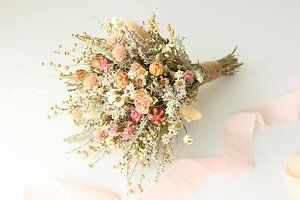One trend that we’ve noticed that has seen significant growth in 2019 is the inclusion of dried flowers in bouquets, especially in the fall and winter wedding seasons. Heading into 2020, this is something we expect to see grow.
A Long-standing Tradition
If you’re having a fall or winter wedding in 2020 we highly recommend adding a dried flower to your bouquet for a wonderful rustic effect that will never go out of style! From the Egyptians to the Victorian era, dried bouquets have been an elegant go-to for brides of all shapes and sizes.
Photo Credit: Bridalwishdesign
Less Worry on Your Special Day
If you build a bouquet that's already-preserved, you save a lot of time and effort later on. The flowers essentially become a keepsake, whether you choose to display them in a vase in your home or make them into potpourri. Not to mention, you don't have to mist dried flowers, they're not as heavy as fresh flowers, and they don't bruise or wilt like fresh flowers do.
Textures
Try to achieve a variety of preserved and dried flowers. The key to a bouquet of this caliber is to create lots of different textures for the eye to explore. Try adding in pampas, wheat, celosias, and other decorative frills to create depth in your bouquet. Dried seed pods and lavender are very popular as well.
Wrap Your Dried Flowers
Dried flowers are very fragile, so it's important to wrap them in tissue paper or craft paper until the big day. For lack of a better term, dried flowers are rather "crispy" and risk breakage of petals and leaves.
Lots of Options After the Wedding
Display the flowers in a vase, make potpourri, press your flowers in a shadowbox, preserve them in gel, or press them into a clear phone case (a popular choice among millenials); the possibilities are endless for the bouquet to live a new life after your special day is over.
Have questions? Leave them in the comments, email us, or go to our Facebook, Instagram, or Pinterest accounts to send us a message! I'm sure Sandy will have an answer for you.
If you're interested in learning more about dried flowers, a great book to check out is Flowers: Growing, Drying, Preserving by Alan Cormack and David Carter.

